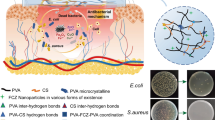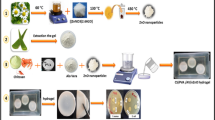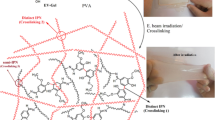Abstract
An antibacterial wound dressing hydrogel was synthesized from biopolymers and a semiconductor nanomaterial by gamma irradiation, and applied in a simulated environment. Polyvinyl alcohol (PVA)/agar hydrogel was chosen due to its biocompatibility and good swelling to absorb wound exudates and make a moist environment to accelerate the wound healing process. Zinc oxide nanoparticles were synthesized and combined with the hydrogel due to their antibacterial activity as a wound dressing aid and the hydrophilic nature to enhance swelling capacity by facilitating water flow in the hydrogel. Hydrogel samples based on PVA/agar containing low amounts of zinc oxide nanoparticles were prepared by gamma irradiation to meet all the requirements of a wound dressing. Water absorption, swelling behavior and pH sensitivity were studied and showed an excellent water swelling capacity. Scanning electron microscopy (SEM) and UV–Vis spectroscopy analyses were employed, where dispersion state of nanoparticles played a key role. Antibacterial activity mechanisms and the resistance to gram-positive bacteria were tested by the disk diffusion method, and the developed hydrogel revealed resistance against gram-positive bacteria. A cone and plate rheometer was used to capture the rheological response of hydrogel. Reduction in viscosity and elastic modulus was due to increasing the amount of zinc oxide nanoparticles. Analyses on mechanical properties approved that hydrogels had enough strength for wound dressing to resist tear once stretched.
Graphic abstract
















Similar content being viewed by others
References
Winter GD (1962) Formation of the scab and the rate of epithelization of superficial wounds in the skin of the young domestic pig. Nature 193:293
Kapanya A, Somsunan R, Phasayavan W, Molloy R, Jiranusornkul S (2020) Effect of molecular weight of poly (ethylene glycol) as humectant in interpenetrating polymer network hydrogels based on poly (sodium AMPS) and gelatin for wound dressing applications. Int J Polym Mater Polym Biomater 70:496–506
Field CK, Kerstein MD (1994) Overview of wound healing in a moist environment. Am J Surg 167:S2–S6
Wallace LA, Gwynne L, Jenkins T (2019) Challenges and opportunities of pH in chronic wounds. Ther Deliv 10:719–735
Debele TA, Su WP (2020) Polysaccharide and protein-based functional wound dressing materials and applications. Int J Polym Mater Polym Biomater 17:1–22
Kumar P, Lakshmanan VK, Biswas R, Nair SV, Jayakumar R (2012) Synthesis and biological evaluation of chitin hydrogel/nano ZnO composite bandage as antibacterial wound dressing. J Biomed Nanotechnol 8:891–900
Tsai HC, Shu HC, Huang LC, Chen CM (2019) A randomized clinical trial comparing a collagen-based composite dressing versus topical antibiotic ointment on healing full-thickness skin wounds to promote epithelialization. Formosan J Surg 52:52
Balakrishnan B, Mohanty M, Umashankar P, Jayakrishnan A (2005) Evaluation of an in situ forming hydrogel wound dressing based on oxidized alginate and gelatin. Biomaterials 26:6335–6342
Li Y, Zhu C, Fan D, Fu R, Ma P, Duan Z, Li X, Lei H, Chi L (2020) Construction of porous sponge-like PVA-CMC-PEG hydrogels with pH-sensitivity via phase separation for wound dressing. Int J Polym Mater Polym Biomater 69:505–515
Khalilipour A, Paydayesh A (2019) Characterization of polyvinyl alcohol/ZnO nanocomposite hydrogels for wound dressings. J Macromol Sci B 58:371–384
Leawhiran N, Pavasant P, Soontornvipart K, Supaphol P (2014) Gamma irradiation synthesis and characterization of AgNP/gelatin/PVA hydrogels for antibacterial wound dressings. J Appl Polym Sci 5:131
Sirousazar M, Khadivi H, Delir S (2020) Swelling and drying mechanisms of freeze-thawed polyvinyl alcohol/egg white/montmorillonite bionanocomposite hydrogels. J Macromol Sci B 59:309–330
Li W, Wu L, Xu Z, Liu Z (2020) Adhesion-to-fibers and film properties of etherified-oxidized cassava starch/polyvinyl alcohol blends. Iran Polym J 29:331–339
Sellappan LK, Anandhavelu S, Doble M, Perumal G, Jeon JH, Vikraman D, Kim HS (2020) Biopolymer film fabrication for skin mimetic tissue regenerative wound dressing applications. Int J Polym Mater Polym Biomater 17:12–18
Liu Y, Lv Y, An M, Li F, Lu Y, Song J (2019) Characterization of chitosan-gelatin blend scaffolds. J Macromol Sci B 58:634–644
Chen W, Bu Y, Li D, Liu C, Chen G, Wan X, Li N (2019) High-strength, tough, and self-healing hydrogel based on carboxymethyl cellulose. Cellulose 27:853–865
Montaser A, Rehan M, El-Naggar ME (2019) pH-Thermosensitive hydrogel based on polyvinyl alcohol/sodium alginate/N-isopropyl acrylamide composite for treating re-infected wounds. Int JBbiol Macromol 124:1016–1024
Raafat AI, Ali AE-H (2019) A novel Lawsonia inermis (Henna)/(hydroxyethylcellulose/polyvinylpyrrolidone) wound dressing hydrogel: radiation synthesis, characterization and biological evaluation. Polym Bull 76:4069–4086
Zeinali A, Sirousazar M, Dastgerdi ZH, Kheiri F (2020) Gelatin/montmorillonite and gelatin/polyvinyl alcohol/montmorillonite bionanocomposite hydrogels: microstructural, swelling and drying properties. J Macromol Sci B 59:263–283
Kim I, Yoo M, Seo J, Park S, Na H, Lee H, Kim S, Cho C (2007) Evaluation of semi-interpenetrating polymer networks composed of chitosan and poloxamer for wound dressing application. Int J Pharm 341:35–43
Massoumi H, Nourmohammadi J, Marvi MS, Moztarzadeh F (2019) Comparative study of the properties of sericin-gelatin nanofibrous wound dressing containing halloysite nanotubes loaded with zinc and copper ions. Int J Polym Mater Polym Biomater 68:1142–1153
Bafandeh MR, Mojarrabian HM, Doostmohammadi A (2019) Poly (vinyl alcohol)/chitosan/akermanite nanofibrous scaffolds prepared by electrospinning. J Macromol Sci B 58:749–759
Sirelkhatim A, Mahmud S, Seeni A, Kaus NHM, Ann LC, Bakhori SKM, Hasan H, Mohamad D (2015) Review on zinc oxide nanoparticles: antibacterial activity and toxicity mechanism. Nano-Micro Lett 7:219–242
Shitole AA, Raut PW, Khandwekar A, Sharma N, Baruah M (2019) Design and engineering of polyvinyl alcohol based biomimetic hydrogels for wound healing and repair. J Polym Res 26:201
Parsa P, Paydayesh A, Davachi SM (2019) Investigating the effect of tetracycline addition on nanocomposite hydrogels based on polyvinyl alcohol and chitosan nanoparticles for specific medical applications. Int J Biol Macromol 121:1061–1069
Gao S, Jiang G, Li B, Han P (2018) Effects of high-concentration salt solutions and pH on swelling behavior of physically and chemically cross-linked hybrid hydrophobic association hydrogels with good mechanical strength. Soft Mater 16:249–264
Pan H, Fan D, Zhu C, Duan Z, Fu R, Li X (2019) Preparation of physically crosslinked PVA/HLC/SA hydrogel and exploration of its effects on full-thickness skin defects. Int J Polym Mater Polym Biomater 68:1048–1057
Schneider LA, Korber A, Grabbe S, Dissemond J (2007) Influence of pH on wound-healing: a new perspective for wound-therapy? Arch Dermatol Res 298:413–420
Ono S, Imai R, Ida Y, Shibata D, Komiya T, Matsumura H (2015) Increased wound pH as an indicator of local wound infection in second degree burns. Burns 41:820–824
Gethin G (2007) The significance of surface pH in chronic wounds. Wounds UK 3:52
Safari J, Zarnegar Z (2014) Advanced drug delivery systems: nanotechnology of health design A review. J Saudi Chem Soc 18:85–99
Godoy-Alvarez FK, González-Torres M, Giraldo-Gomez DM, Sánchez-Sánchez R, Pérez-Díaz MA, González-Del Carmen M, Figueroa-González G, Reyes-Hernández OD, Sharifi-Rad J, Cortés H (2021) Synthesis by gamma irradiation of hyaluronic acid-polyvinyl alcohol hydrogel for biomedical applications. Cell Mole Bio 67 (1):58–63
Khorasani MT, Joorabloo A, Adeli H, Mansoori-Moghadam Z, Moghaddam A (2019) Design and optimization of process parameters of polyvinyl (alcohol)/chitosan/nano zinc oxide hydrogels as wound healing materials. Carbohydr Polym 207:542–554
Glass S, Kühnert M, Abel B, Schulze A (2019) Controlled electron-beam synthesis of transparent hydrogels for drug delivery applications. Polymers 11:501
Loh EYX, Mohamad N, Fauzi MB, Ng MH, Ng SF, Amin MCIM (2018) Development of a bacterial cellulose-based hydrogel cell carrier containing keratinocytes and fibroblasts for full-thickness wound healing. Sci Rep 8:2875
Hsieh HT, Chang HM, Lin WJ, Hsu YT, Mai FD (2017) Poly-methyl methacrylate/polyvinyl alcohol copolymer agents applied on diabetic wound dressing. Sci Rep 7:9531
Salimi-Kenari H, Mollaie F, Dashtimoghadam E, Imani M, Nyström B (2018) Effects of chain length of the cross-linking agent on rheological and swelling characteristics of dextran hydrogels. Carbohydr Polym 181:141–149
Mahinroosta M, Farsangi ZJ, Allahverdi A, Shakoori Z (2018) Hydrogels as intelligent materials: a brief review of synthesis, properties and applications. Mater Today Chem 8:42–55
Eke G, Mangir N, Hasirci N, MacNeil S, Hasirci V (2017) Development of a UV crosslinked biodegradable hydrogel containing adipose derived stem cells to promote vascularization for skin wounds and tissue engineering. Biomaterials 129:188–198
Oliveira R, Rouzé R, Quilty B, Alves G, Soares G, Thiré R, McGuinness G (2014) Mechanical properties and in vitro characterization of polyvinyl alcohol-nano-silver hydrogel wound dressings. Interface Focus 4:20130049
Rahmati M, Milan PB, Samadikuchaksaraei A, Goodarzi V, Saeb MR, Kargozar S, Kaplan DL, Mozafari M (2017) Ionically crosslinked thermoresponsive chitosan hydrogels formed in situ: a conceptual basis for deeper understanding. Macromol Mater Eng 302:1700227
Swaroop K, Somashekarappa H (2018) In vitro biocompatibility and antibacterial activity of gamma ray crosslinked ZnO/PVA hydrogel nanocomposites. Mater Today Proc 5:21314–21321
Abdeen ZI, El Farargy AF, Negm NA (2018) Nanocomposite framework of chitosan/polyvinyl alcohol/ZnO: preparation, characterization, swelling and antimicrobial evaluation. J Mol Liq 250:335–343
El-Mohdy HA (2013) Radiation synthesis of nanosilver/poly vinyl alcohol/cellulose acetate/gelatin hydrogels for wound dressing. J Polym Res 20:177
Zhang L, Wang Z, Xu C, Li Y, Gao J, Wang W, Liu Y (2011) High strength graphene oxide/polyvinyl alcohol composite hydrogels. J Mater Chem 21:10399–10406
Mallakpour S, Darvishzadeh M (2018) Nanocomposite materials based on poly (vinyl chloride) and bovine serum albumin modified ZnO through ultrasonic irradiation as a green technique: optical, thermal, mechanical and morphological properties. Ultrason Sonochem 41:85–99
Zaid M, Hafiz M, Matori KA, Abdul Aziz SH, Zakaria A, Ghazali M, Sabri M (2012) Effect of ZnO on the physical properties and optical band gap of soda lime silicate glass. Int J Mol Sci 13:7550–7558
Singh P, Kumar A, Kaushal A, Kaur D, Pandey A, Goyal R (2008) In situ high temperature XRD studies of ZnO nanopowder prepared via cost effective ultrasonic mist chemical vapour deposition. Bull Mater Sci 31:573–577
Kanade K, Kale B, Aiyer R, Das B (2006) Effect of solvents on the synthesis of nano-size zinc oxide and its properties. Mater Res Bull 41:590–600
Khozemy EE, Nasef SM, Mahmoud GA (2018) Synthesis and characterization of antimicrobial nanocomposite hydrogel based on wheat flour and poly (vinyl alcohol) using γ-irradiation. Adv Polym Technol 37:3252–3261
Razzak MT, Darwis D (2001) Irradiation of polyvinyl alcohol and polyvinyl pyrrolidone blended hydrogel for wound dressing. Radiat Phys Chem 62:107–113
Author information
Authors and Affiliations
Corresponding author
Rights and permissions
About this article
Cite this article
Arab, M., Jallab, M., Ghaffari, M. et al. Synthesis, rheological characterization, and antibacterial activity of polyvinyl alcohol (PVA)/ zinc oxide nanoparticles wound dressing, achieved under electron beam irradiation. Iran Polym J 30, 1019–1028 (2021). https://doi.org/10.1007/s13726-021-00952-7
Received:
Accepted:
Published:
Issue Date:
DOI: https://doi.org/10.1007/s13726-021-00952-7




